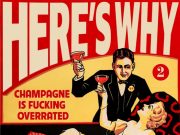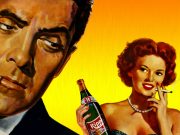Every dedicated drinker knows what they’re really doing it for. It’s not our health — it’s training.
You know what I’m talking about. Some freaks get up before dawn to go and row the rivers shirtless, getting satisfaction, feeling vital and alive. Others run in groups of twelve, all at the same pace like some kind of centipedal super-being—taut-calved assless pod people. Still more choose to build their bodies through resistance, from urbanites taking turns at the squat racks to country-fried warriors tearing tree trunks out of the ground.
But we—you, me, real boozehounds—train ourselves in different ways, knowing as we do that we are all soon going to die.
It happens to the best of us; when it’s our turn, we’ll be ready for it.
We touch the face of death with every blacked-out night spent twirling in the streets with blinkered vision. We invite the dangerous moments that may prove to be our last.
This very night may be the one that we mistake the lamplight of the next pub for the headlights of a speeding box truck; the night on which our loving lean against the sturdy ATM marks us as perfect targets for the knife of some more desperate knave; the night our brains just crack in twain and go simply kaput, having divined some uncontainable truth triggered by the right percent of BAC.
The dream is that we won’t see it coming. But in that most audacious year of 2020, we were made to see it coming every single dreadful day.
Death was in the air around us, literally, in every place we once sought shelter so we could escape our homes. It was hiding in the lungs of our families, slick on the hands of our friends, and on the lips of every stranger we once regarded with “why not?”
 If any drinker predicted the pandemic, it was entirely by accident. But a literal prediction wasn’t necessary for what real drunks did have in the pocket, and that is preparation. Preparation for ruin, whether personal or global in scale, with the certainty that the “expert” response to big disaster would be incredibly stupid. We went into this pandemic with near-divine foreknowledge that the apocalypse was nigh, and when the apocalypse is actually happening, that kind of personal readiness turns out to be pretty important.
If any drinker predicted the pandemic, it was entirely by accident. But a literal prediction wasn’t necessary for what real drunks did have in the pocket, and that is preparation. Preparation for ruin, whether personal or global in scale, with the certainty that the “expert” response to big disaster would be incredibly stupid. We went into this pandemic with near-divine foreknowledge that the apocalypse was nigh, and when the apocalypse is actually happening, that kind of personal readiness turns out to be pretty important.
By the time the first corona-riddled body collapsed in the filth and street sludge off the curb of some faraway sidewalk, we were already ordering an appetizer to go with our third beer. By the time it all actually got here . . . well . . . we were drunk.
* * *
“Come on in,” a man called from his barstool on the afternoon of March 15, at a place called Hair of the Dog on the Lower East Side of Manhattan. The sky was blue, the sun was warm, and the air only felt chilly if you stayed still under shadow — by most metrics, a perfect day. The man was beckoning to passersby, calling them to join him like a siren on the rocks. “Come on,” he said. “Catch the virus.”
To say he was speaking through the window would be inaccurate. It seemed a whole wall of the place was thrown open in an effort to air the place out, out of an abundance of caution in that brief flailing moment when we were all pretty sure the world was ending, but we’d not yet ducked and covered. This was just days after Broadway went dark, the NBA shut down, and God save her, we still weren’t totally certain if Rita Wilson was going to make it. The portcullis was falling; this was the true last call.
* * *
When New York City went on lockdown, it stayed that way for almost an entire year, with the biggest social engagements generally being battles with the police. Communal interiors were outlawed for our own good — the dives, the dance clubs, the karaoke joints; the bars-slash-bowling alleys, the coffee shops-slash-concert venues; the art shows with free wine, the movie theaters with expensive beer.
In a bid of wartime solidarity, distilleries around the country set to work making hand sanitizer. To hell with that — in retrospect they should’ve all been requisitioned to churn out liters of grain alcohol, to be hand-delivered to our porches by white-gloved modern-day milkmen. In an ideal country, we would’ve devoted a trillion dollars to keeping us all pickled, wasted, and otherwise sedated, safely soused within our homes until the whole thing blew over.
Instead, we were left to our own devices—we made our own fun. For months in the leadup to the Fourth of July, fireworks went off day and night in New York City, bulk stocks of illicit explosives doled out en masse by the boroughs’ well-connected uncles. Some nimbys didn’t like this, but I’d like to think most people saw each unsanctioned crack of shot and burst of light for what it really was — an expression of joy and persisting existence. It was a whole lot less obnoxious than the 7pm clap.
Amidst so much darkness and isolation, it warmed my heart to stand atop my building’s roof with a cold drink to see the fireworks at something closer to eye level, knowing there were people in the streets beyond my sightline who were still staying up, getting out, running wild, having fun.
* * *
In spring and summer 2020, I was living in East Brooklyn, in a neighborhood that many sources over decades have described as “blighted.” I didn’t have a problem with it—the fruit stand lady liked me—but things got pretty untenable as the new global blight arrived.
In the space that I was living in, people began coming and going with some frequency, either flying the coop or looking for refuge. One of them, a self-described communist, fled the state in the dark of night as soon as the city shut down, a move that I found more cowardly than comradely. I believe he ran off to the Pacific Northwest, presumably picking up sword and shield with a gang of black bloc freedom fighters united in their mission to once and for all destroy Oregon.
Not long after his departure, the building caught fire amid riots in the streets. The events weren’t connected, but it certainly felt like they were, two great disruptions bound together by a sense of surreality.
While the structure stayed standing and relatively unburned, the electricity and hot water capacity of the building was destroyed indefinitely. This was early in the pandemic; we had nowhere else to go. The bloodless freak who owned the building, a woman-beating multi-millionaire, all but abandoned his post. Anarchy came home. No power, no water, the city on fire, miasma in the air. The elements were united against us; all we would’ve needed to run the series would’ve been a goddamn earthquake.
Like so many others, we organized a rent strike, or at least made the effort to; the effort being undercut by the revelation that several of our neighbors had been “rent striking” since 2019, well before the act had adopted any kind of moral heft. These were true scumbags; I admired them quite deeply.
One of these brazen layabouts was Hank, our downstairs neighbor, a man whom I mostly knew for air-frying me good chicken wings, and also selling me drugs. As the weather warmed intolerably both inside and out of our unlit apartments, Hank decided to resume his longstanding tradition of parties on the rooftop, powering an amplifier from an unknown source with an exceptionally long extension cord.
Shortly after I’d first moved into the top floor of this building, years prior, a gigantic pipe of lethal weight had burst down through our ceiling. It crashed through in one of the bathrooms, taking a mirror off the wall and dangling in a corner precariously, Looney Tunes-style, the sky above clearly visible through its long and hollow core. Now, in 2020, I was on the roof myself, drinking Hank’s beer and dancing terribly with his relatives, trying to do my part to drink and stomp and holler and take the rest of the building down.
On another night around this time, I stood on the roof by myself, watching the sun go down, no less than ten helicopters hovering in my field of vision between there and Manhattan. It was already dark in my apartment; at least up here I could enjoy what was left of the day’s fading light, staying out past curfew, listening to the sirens as they wailed into the night.
* * *
In a year of panicked suppression, the only social engagements were necessarily acts of rebellion, whether they took the form of street uprisings or more selfish-looking acts. All of these events were risky. Lives were ruined. Some had the veneer of justice to them but make no mistake — very little of it was truly selfless. Whether people were out throwing beer bottles full of gas at cop cars or getting gassed up on liquor at illicit boat, bus, or rooftop parties, history should afford some space to the notion that every wild thing we did that year was borne chiefly out of boredom.
Everywhere, the state emerged to shut the good times down. A lot of these ideas were stupid but understandable. The safest places turned out to be our rooftops, in numbers small enough to avoid the searchlights’ glare.
When the story of this locked-down year is finally finished being written, I will remember the readiness with which we all fled to high ground, scaling fire escapes, unlocking roof hatches, and climbing ladders to some kind of freedom. In the exceptionally joyous 2005 documentary Dave Chappelle’s Block Party, a patron of said party remarks that the real New York City is on the rooftops, and this has been the story for well over one hundred years. In the 1890s, “rooftop garden” culture gained traction in the city as an emerging, affordable trend; by the time of the first Roaring ‘20, that trend was a full-blown frenzy. To this day, the rooftops are a place to find perspective, to see and not be seen, resting at one’s leisure, towering above the rest.
During the pandemic, these roofs became the safest places to sit with friends and drink, provided you kept a safe and social distance from the building’s lofty edge. Some people had good setups — patio furniture, parasols, tomatoes in wood boxes growing sweetly on the vine. Some people had real-deal balconies, the sorts of perks for the straight-up rich that allow them to forget their proximity to the mess of life surrounding them.
These were places I was lucky enough to be invited to. My own experiences were much more salt of the earth, if several stories removed from it. My balcony was a fire escape, laden with found throw pillows, sharing space with a squat charcoal grill and some plants that proved unkillable. My memories are of sprawling across roofs that were warped and bubbling, not meant to be trodden upon, hot to the touch in the daylight. These oft-forbidden places bore the bootprints and sloppy workmanship of my unknown forebears who had put it all together — a roof over my head at night, a daylight beach of tar.
You didn’t even need to be drinking to take part in this phenomenon, not really. People did yoga up there. They hosted dance classes, taught themselves instruments and obscure weapons like bo staffs and nunchaku. There’s a reason why people pay so much to live on the top floors. You can do whatever you want up there, away from prying eyes. Justin, a friendly bartender at a place called Lowlands not too far from the current roof over my head, spent some of his time on the rooftop debating the merits of libertarian philosophy with a Greek socialist with whom he happened to share the same building; there as in the wider world, the matter remains unsettled.
These roofs weren’t foolproof oases. For every thousand people who found a reason to keep waking up amid the sunshine on their private perch, there was probably one who fell over the edge, on accident or on purpose — an opportunistic escape. As I write this, it looks like they’re probably going to start cracking down on allowing people up there; where some see freedom, others see liability, and 2020 did make so many people obsessed with rules.
* * *
We got so fucked up in 2020 — what good times are we supposed to remember? Our pockets were picked, our friends disappeared, and every evil force in the world got stronger off our misery. The hangover is brutal. Somebody, pour me a drink.
The fact that this all really happened is already becoming harder to remember amid the great unmasking. It is as though the whole year is dissolving into a fragmented, foggy memory, the product of a bender on a grand international scale.
* * *
Many of us — you, me, modern drunkards — spend our lives in the gutter, stepped on and passed over, dead broke and/or broke down. We’re victims of circumstance, self-inflicted or otherwise. By the time we’re old enough to drink, we’re already world-weary. We’ve seen this place for what it is. But at the start of the new roaring twenties, for one long stretch, everyone else we knew in life began to see it too. This world is trying to kill us; if you hadn’t noticed, bless your heart.
In the post-pandemic years to come, we’ll live through so much more. There will be times much worse than this, but we’re all prepared for it now. When we reach those lowest points, there’s nowhere to go but up.
When the world does burn again, we’ll live for the times that we rose above the flames, our wild eyes turned firmly to the void beyond our atmosphere, our laughter echoing through the streets from which we could not be seen.
—Sarah Szabo











Wow! You’re quite a writer. This piece is so dense (I mean that in a good way), I’ll read this a number of times. Each time, I’ll nod my head in a knowing way or simply in agreement to something I missed before. It’s time to finish my AM martini while my wife is still outside throwing away the garbage and checking the mailbox. Really nice piece of work here.